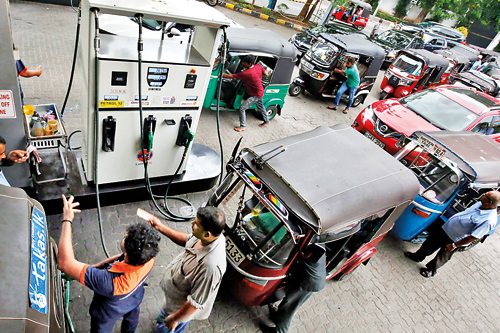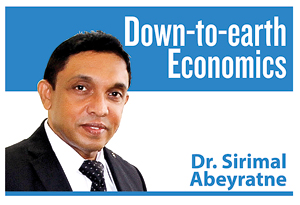Battered with fuel prices
View(s):
Queue at a Fuel Station
Following speculation that a fuel bowser would be arriving the next day to the fuel station, lorries, buses, vans and other vehicles lined up along the road to spend the night in the diesel queue. In some of the places, even the tourist buses with foreign tourists on board were seen parked in the queue for hours for fuel. There are similar queues of motor cars, tuk-tuks and motorcycles for petrol as well.
There were also lines of people with big plastic cans to purchase diesel. Some of them were hired by the vehicle owners by paying them a daily wage of Rs. 3,000 to stay in the fuel queue; it is worth rather than bringing the vehicle and staying it in the queue losing days of work. Some others were hired by the black-market fuel vendors who used to sell diesel by adding further Rs. 100 per litre. All these practices are employment and business opportunities created by the country’s chaotic fuel supply.
After all, business means business; it is the consumers who should bear all the additional costs of all types of economic activities – production, storage, transport and delivery of goods and services. The tragic cases of violence, aggression, collapses and deaths were also reported in the fuel queues from time to time.
Fuel price hike
It was in this backdrop that this week there was a sharp increase in local fuel prices in the country’s duopoly market dominated by the Lanka IOC and the state-owned CEYPETCO. On April 17, the Lanka IOC increased the petrol prices by Rs. 35 per litre and diesel by Rs. 75 a litre. Next day, CEYPETCO too raised the fuel prices by similar amounts.
The fuel price hike resulted in an escalation of the country’s public protests which turned to violent forms, causing disturbances to day-to-day life of the people, clashes with the Police and, injuries and a death. Already faced with the supply shortages of daily essentials as well as their increasing prices over the last couple of months, the sharp increase in fuel prices has caused a multiplication of people’s hardship, frustration and anger.
Public comments over the fuel price increase which appeared in the media seem to have been directed at the government: It’s the government which has allowed the suppliers to increase fuel prices arbitrarily; it’s the government which has done this together with fuel suppliers; it’s the government which should prevent the suppliers from increasing the fuel prices; it’s the government which should determine the fuel prices, not the fuel suppliers.
After all, it is true that it is the economic mismanagement of the incompetent government which has caused both fuel supply shortages and fuel price hikes in the country. Before we elaborate this point, however, it is necessary to look at the overall picture.
From world price to local price
From a Sri Lankan point of view, a crude oil barrel was Rs. 14,000 in 2022; it was about US$70 in the world market, while the exchange rate was about Rs. 200 per US dollar. Today, the international price of a crude oil barrel has increased to $105, while the rupee-dollar exchange rate is about 335; as a result, a crude oil barrel now costs over Rs. 35,000.
 After the increase in fuel prices, a litre of petrol (Octane 95) in Sri Lanka is about $1.10 and a litre of diesel about $0.87; in fact, these prices are still in the “lower” price range in the world. Sri Lanka’s fuel prices are still lower than those of many of our neighbouring countries in Asia including India, China, Thailand, Bangladesh, Nepal, Maldives, Bhutan, Indonesia, Cambodia, and Vietnam.
After the increase in fuel prices, a litre of petrol (Octane 95) in Sri Lanka is about $1.10 and a litre of diesel about $0.87; in fact, these prices are still in the “lower” price range in the world. Sri Lanka’s fuel prices are still lower than those of many of our neighbouring countries in Asia including India, China, Thailand, Bangladesh, Nepal, Maldives, Bhutan, Indonesia, Cambodia, and Vietnam.
There is no dispute about the fact that local fuel prices are influenced largely by their world market prices, which are beyond our control. If there are cross-country differences in local fuel prices, that is due to domestic taxes and subsidies as well as productivity differences in oil refining and distribution. The bottom line is that a country’s income level has nothing to do with the ‘globalised’ oil prices. Therefore, a country like Sri Lanka must accept the world fuel prices as they are and, try to improve the domestic conditions resulting in higher fuel prices.
Fuel cost is a significant portion of the input cost of production affecting economic competitiveness of businesses, industries, transport, and exports as well as the cost of some other inputs like electricity. Thus, when the fuel prices are on the rise, the prices of everything else should go up too. This has been one of the contributory factors of Sri Lanka’s current high inflation. The rate of inflation in Sri Lanka exceeded the Central Bank’s upper margin inflation target of 6 per cent in October 2021 and, then reported a steady increase every month reaching 18.7 per cent in March 2022.
Prepare for the worst
Exchange rate depreciation, as the major contributory factor to the unprecedented fuel price hike has not come to an end. As the rupee-dollar exchange rate is due to depreciate further, there is nothing unusual to say that the fuel prices too would continue to rise in the coming weeks and months even if its dollar prices continue to remain the same in the world market.
Sri Lanka has to spend about $4 billion a year to import fuel, which is closer to 20 per cent of the country’s total import expenditure; as local demand increases or world price rises, this share must go up further. The country’s total import expenditure is about $22 billion, which is twice its export income. Exports, tourism income and worker remittances – all would come to $22 billion – just to cover the import expenditure. During the past two years, Sri Lanka lost its tourism income of about $4 billion and a sizable segment of workers’ remittances.
Apart from the total import expenditure, Sri Lanka must meet its debt service payments which now remain around $5 – 6 billion a year. Thus, it is an important question to ask as to how we did manage about $8 – 10 billion during the past two years. It was possible only through unsustainable means of further borrowings and import controls.
While we still need this $8 – 10 billion foreign exchange inflow to cover the country’s import expenditure and debt service payments, both the borrowings and import controls have now come to their limits. No lenders give you unlimited loans, while import controls squeeze business and production, and even export earnings.
Because there is no source of additional foreign exchange inflows in sight for the coming months, the exchange rate is bound to depreciate further, and the supply shortages bound to worsen further.
Lamenting on the past
A critically important question that anyone should ask the government is what were the steps that the government took during the past two years? In fact, there was none! If we take a longer-term perspective on the country’s foreign exchange crisis, all sorts of analyses could be reduced to one important source of foreign exchange inflows — export growth. The intense demand for policy reforms to enhance export growth over the past 10 – 20 years has fallen on deaf ears!
Although lamenting over the past is a futile exercise, it shed lights on what is to be done even at this juncture. While the central policy thrust must be export growth, a medium-term macroeconomic reform programme and a restructuring of public enterprises including the CPC and the CEB are vital components that support export growth too.
How does export growth solve the fuel price hikes and fuel shortages? It is export growth that would end the foreign exchange shortage in a sustainable manner. It would generate sustainable cash flow to finance imports of fuel and others and build up non-credit based reserves. As far as an end to exchange rate depreciation is concerned, there is no other remedy than export growth.
(The writer is a Professor of Economics at the University of Colombo and can be reached at sirimal@econ.cmb.ac.lk and follow on Twitter @SirimalAshoka).
Hitad.lk has you covered with quality used or brand new cars for sale that are budget friendly yet reliable! Now is the time to sell your old ride for something more attractive to today's modern automotive market demands. Browse through our selection of affordable options now on Hitad.lk before deciding on what will work best for you!


